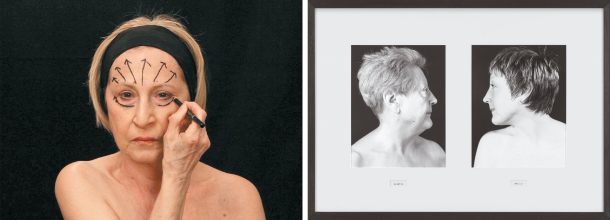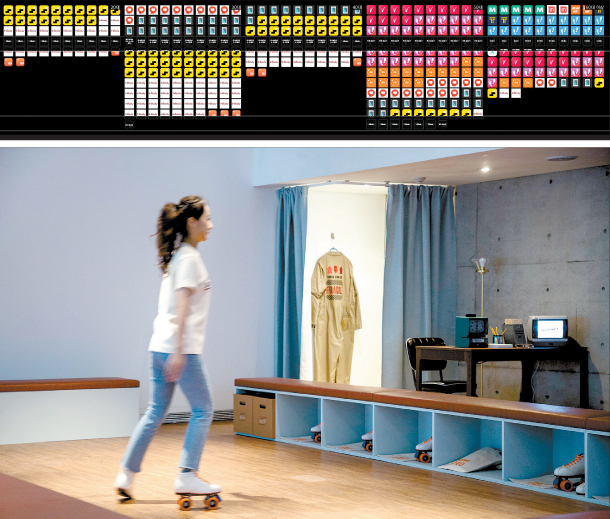Understanding beauty that comes with age: Exhibit celebrates the diverse ways artists depict human aging

Left: “Beauty + Beastly” (1974/2009) Right: “Instruction #2” (2015) by Sanja Ivekovic [COREANA MUSEUM OF ART]
Ironically, Korea is also the fastest aging country in the world - birth rates have hit rock-bottom and immigration is still relatively uncommon. Over 14 percent of the population was estimated to be over 65 as of 2017, and that ratio is expected to leap to 20 percent by 2026.
The exhibition “Youth Before Age” presents diverse ways of thinking about youth, age and generations in this paradoxical time and showcases works critical of the social pressures to look young. The 13 participating artists and teams include prominent feminist artists, like Sanja Ivekovic and Martha Wilson. The artists also vary in age, with five of them being over 60.
While it’s rare for any contemporary art show to feature such a high proportion of participants from that generation, what’s perhaps more surprising is the fact that the exhibition is curated by and held at the Coreana Museum of Art in southern Seoul, a gallery operated by Coreana, one of Korea’s oldest cosmetics brands since 1988.
“It’s true that we are part of a cosmetics company, but we don’t follow its corporate direction in our exhibitions,” explained Park Hye-jin, curator of “Youth Before Age.”
“Coreana is also welcoming of the diverse perspectives on these issues, and I think works in this exhibition also showcase opposing perspectives,” she continued, adding that the museum has organized exhibitions that presented a critical look at similar themes in the past. “It’s problematic if people pursue anti-aging excessively, but the reality is that you can’t say that trying to stay young is necessarily bad.”
As Park said, many of the works in “Youth Before Age” are critical of how youth is associated with beauty.

Top: “Investigation on the Installation of Mobile Apps, According to Age Groups, as of Week 4, July, 2019” (2019) by Particlefield Above: “Unbalance” (2019) by Kim Ga Ram [COREANA MUSEUM OF ART]
“
But as works by male artists Kwak Nam-sin and Johnny Symons demonstrate, the pressure to look young for social acceptance is not limited to just women. Kwak, who is in his 60s, chose to take a jab at some men’s obsessive desire for youth by comically exaggerating the strained expressions of bodybuilders as they endure considerable pain to bulk up their muscles.
Symons’ award-winning documentary film “Beauty Before Age” (1997) interviews gay Americans to reveal how they also feel pressure to look young and fear growing old, as desirability declines with age.
By contrast, works by Seline Baumgartner and Ari Seth Cohen present older people not as an object of pity or contempt, but rather of admiration and respect. Cohen’s “Advanced Style” (2012 - ), for example, is an ever growing collection of photographs featuring very fashionable older women spotted in the streets of New York and elsewhere. Their vibrant colors and confident expressions appear to proclaim that youth is in the mind, and beauty, timeless.
Similarly, “Nothing Else” (2014) by Baumgartner is a video work featuring four active dancers in their 50s to 70s, rare in an industry where the average retirement age is notoriously low. In the video, the dancers explore how different aspects of dance, like flexibility, change with age.
Some of the works take a closer look at generational gaps and possible misunderstandings. Particlefield’s “Investigation on the Installation of Mobile Apps, According to Age Groups, as of Week 4, July, 2019” (2019) graphically presents the differences in the type and speed of mobile apps each age demographic downloads, pointing to the growing problem of “digital exclusion” for older people.
Kim Ga Ram’s “Unbalance” (2019) adds interactive fun to the exhibition. For “Youth Before Age,” the artist installed a roller skate rink to remind visitors of their younger days, encouraging them to put on a pair of skates from the many sizes available and listen to music from their favorite decade. But as the name of the work suggests, only one of the skates are equipped with wheels, which symbolize unbalance and anxiety as two defining characteristics of youth.
BY KIM EUN-JIN [kim.eunjin1@joongang.co.kr]
The exhibit runs through Nov. 9. The museum’s hours are from 10 a.m. to 7 p.m. through October, and 6 p.m. in November, except Sundays. Tickets are 4,000 won ($3.30) for adults and free for visitors over 65 and under 7.










with the Korea JoongAng Daily
To write comments, please log in to one of the accounts.
Standards Board Policy (0/250자)